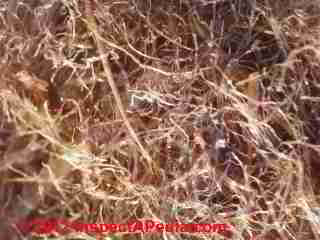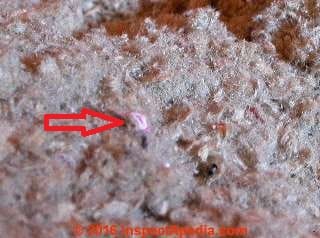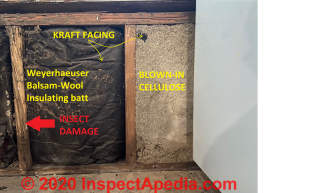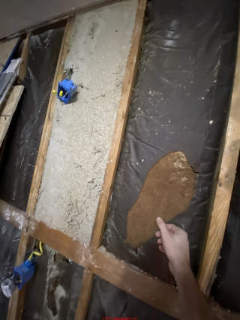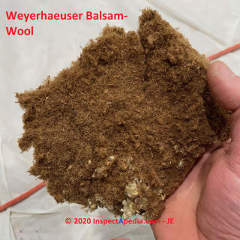 Balsam Wool vs Cellulose Building Insulation How to tell which is which, R-values
Balsam Wool vs Cellulose Building Insulation How to tell which is which, R-values
- POST a QUESTION or COMMENT about the properties & identification of balsam wool & cellulose insulation materials
What's the difference between Balsam Wool insulation and Cellulose insulation and what are their different properties.
This article series provides photos and text to allow identification of just about every building insulation materials and includes the properties, uses, inspection, and proper installation of building insulation.
InspectAPedia tolerates no conflicts of interest. We have no relationship with advertisers, products, or services discussed at this website.
- Daniel Friedman, Publisher/Editor/Author - See WHO ARE WE?
How to Distinguish Between Balsam Wool & Cellulose Insulation
Balsam wool insulating blanket used wood fibers from tree bark, wood pulp, or other lumber byproducts.
As such it is a wood or cellulose product.
But paper is also made from cellulose or wood materials. So what's are the differences between balsam wool and cellulose insulation?
Can we see the difference in the field.
Yes, absolutely, and with ease.
Our balsam wool insulation photo, just above, shows the typical wood fibers of light brown or tan balsam wool insulation under a microscope.
Cellulose insulation, installed either as a dry in-fill or wet spray process, is made from chopped newsprint or similar recycled paper products, treated with a fire retardant chemical, usually a borate salt.
Below we our arrow points to a typical newsprint fragment that can sometimes be identified in gray cellulose building insulation.
With special thanks to InspectApedia.com reader J.E. We continue with a description of a home whose walls were insulated first with Weyerhaeuser Balsam-Wool Insulating batts and then re-insulated by blowing-in dry cellulose insulation.
Reader Comment: House walls reveal combined Balsam Wool & Blown-in Cellulose Insulation
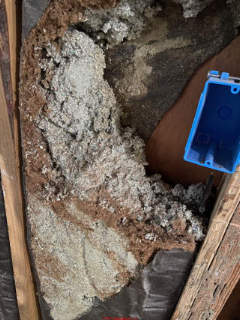 I stumbled on your website while flipping my 1950’s home throughout the past year. One of the many mysteries I've encountered along the way is, “What the heck is this insulation?
I stumbled on your website while flipping my 1950’s home throughout the past year. One of the many mysteries I've encountered along the way is, “What the heck is this insulation?
I was able to learn a lot through your site and was finally able to get a good idea of what the house was originally insulated with! Then, as fate would have it, in the very last room I demoed almost a year later, I found a batt with a label on it. Ha!
[Click to enlarge any image]
Shown at left: the reader's home's wall cavities contain a mix of blown-in cellulose and balsam wool batt insulation later identified as by Weyerhaeuser.
I don’t know if it helps with your efforts any, but I scanned the label and took samples of the insulation, which I have kept in sealed baggies.
If those are of value to you in any way, please let me know, and I’d be happy to mail them. Otherwise, I’ll be discarding them soon. I just wanted to offer to do anything I can to support your awesome efforts and database of knowledge!
Attached [shown below] is the Balsam Wool label and some various photos.
As best I can tell, the Balsam Wool was original.
I’m guessing some of the bags collapsed at some point in their life, because some of them were very flat.
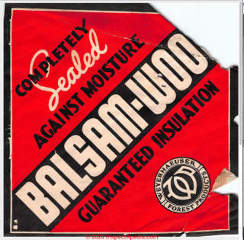 In the flat spots were what I think was some form of cellulose.
In the flat spots were what I think was some form of cellulose.
There were also random plugged holes (about 2”x2”) at almost every stud cavity along the exterior wall.
I’m guessing an owner at some point cut in and did blow-in cellulose to fill gaps. It was even mixed into the Balsam at spots.
The photos shown here were contributed by InspectApedia.com reader JE.
Moderator reply: Weyerhaeuser Balsam-Wool Insulating batts in black kraft paper mixed with later-addition of blown-in cellulose insulation
I agree that there are two generations of insulation here.
First balsam wool was installed in kraft-paper-faced batts, perhaps at time of original construction of the building.
Then later someone blew cellulose into the walls (through those plugged holes you found) later in the life of the house, and that it ended up in several configurations:
- filling an empty joist bay cavity,
- pushing on top of the interior side of black paper balsam wool insulation facing, and
- pushing in on the interior side of that facing at other points, mixing with the balsam wool.
Below we see a black kraft-faced balsam-wool insulating batt (on the left in the photo) while on the right is cellulose insulation that was blown into the wall cavity later.
At the upper right of the cellulose-insulated stud bay we see a spot of black kraft paper suggesting that just behind the cellulose is the original balsam-wool batt.
I suspect that the cellulose we see was simply blown atop the kraft faced balsam wool - an impressive insulation retrofit job by the installer.
Watch out: in the photo above we see what looks like termite damage to the cripple stud. [Click to enlarge any image]
In the photo below, the black kraft facing looks the same both on the dark brown balsam wool and on the light gray insulation in the panel below that hanging electrical receptacle - showing a mix of both kinds of insulation, balsam wool and cellulose.
In others we can see that cellulose was blown in such that some of it was pushed between the balsam wool kraft facing and whatever was on the wall.
As you demonstrated below with two hand-held samples of blown-in insulation, one can easily ID cellulose insulation by close inspection, finding bits of newsprint, sometimes colored, and on occasion I can actually pick out a bit with a newsprint letter on the paper. Balsam wool is more-uniformly brown wood fibre material.
Above and below: brown fibrous insulation is Weyerhaeuser. Balsam-wool while the gray-colored fuzzy soft insulation is cellulose - typically made from chopped newsprint.
Compare the Insulating R-Values of Balsam Wool vs Cellulose Insulation
- Balsam wool's R-value is about R 2 - 3.5 per inch
- Cellulose insulation's R-value depends on how it was applied (wet spray vs. dry loose-fill) and is about R 2.8 to R 3.8
See INSULATION R-VALUES & PROPERTIES for an extensive table describing the properties of different insulating materials used in buildings
Details about cellulose insulation are
at CELLULOSE LOOSE FILL INSULATION
...
Continue reading at BALSAM WOOL BATT INSULATION or select a topic from closely-related articles below, or select a topic from the closely-related articles below, or see the complete ARTICLE INDEX.
Or see BALSAM WOOL BATT INSULATION FAQs - questions and answers about balsam wool insulation posted originally on this page.
Or see these
Recommended Articles
- ASBESTOS INSULATION - to distinguish from wood or fiberglass
- BALSAM WOOL BATT INSULATION
- BALSAM WOOL vs CELLULOSE INSULATION
- BLOWN-IN INSULATION
- CELLULOSE LOOSE FILL INSULATION
- FIBER & HAIR IDENTIFICATION
- FIBERBOARD SHEATHING - another wood fibre insulating product in board or panel form
- INSULATION IDENTIFICATION GUIDE - topic home
- INSULATION LOCATION - WHERE TO PUT IT
- INSULATION R-VALUES & PROPERTIES
Suggested citation for this web page
BALSAM WOOL vs CELLULOSE INSULATION at InspectApedia.com - online encyclopedia of building & environmental inspection, testing, diagnosis, repair, & problem prevention advice.
Or see this
INDEX to RELATED ARTICLES: ARTICLE INDEX to BUILDING INSULATION
Or use the SEARCH BOX found below to Ask a Question or Search InspectApedia
Ask a Question or Search InspectApedia
Try the search box just below, or if you prefer, post a question or comment in the Comments box below and we will respond promptly.
Search the InspectApedia website
Note: appearance of your Comment below may be delayed: if your comment contains an image, photograph, web link, or text that looks to the software as if it might be a web link, your posting will appear after it has been approved by a moderator. Apologies for the delay.
Only one image can be added per comment but you can post as many comments, and therefore images, as you like.
You will not receive a notification when a response to your question has been posted.
Please bookmark this page to make it easy for you to check back for our response.
IF above you see "Comment Form is loading comments..." then COMMENT BOX - countable.ca / bawkbox.com IS NOT WORKING.
In any case you are welcome to send an email directly to us at InspectApedia.com at editor@inspectApedia.com
We'll reply to you directly. Please help us help you by noting, in your email, the URL of the InspectApedia page where you wanted to comment.
Citations & References
In addition to any citations in the article above, a full list is available on request.
- In addition to citations & references found in this article, see the research citations given at the end of the related articles found at our suggested
CONTINUE READING or RECOMMENDED ARTICLES.
- Carson, Dunlop & Associates Ltd., 120 Carlton Street Suite 407, Toronto ON M5A 4K2. Tel: (416) 964-9415 1-800-268-7070 Email: info@carsondunlop.com. Alan Carson is a past president of ASHI, the American Society of Home Inspectors.
Thanks to Alan Carson and Bob Dunlop, for permission for InspectAPedia to use text excerpts from The HOME REFERENCE BOOK - the Encyclopedia of Homes and to use illustrations from The ILLUSTRATED HOME .
Carson Dunlop Associates provides extensive home inspection education and report writing material. In gratitude we provide links to tsome Carson Dunlop Associates products and services.


